Water department helps divert oyster shells from landfills while protecting source water
June 29, 2022

AWWA Articles
Water department helps divert oyster shells from landfills while protecting source water
Each year, Philadelphia diners send 20 to 40 tons of spent oyster shells to the landfill.
Yet reusing those shells can create a healthier watershed, thanks to a blue infrastructure project the Philadelphia Water Department recently helped launch.
“Mother Nature knows best,” said Lance Butler, senior scientist with the Philadelphia Water Department’s (PWD) Office of Watersheds. “We’re using native biology to provide ecosystem benefits.”
 PWD partnered with the Partnership for the Delaware Estuary to recruit a handful of local restaurants to collect spent oyster shells so they can be cleaned and returned to the Delaware River watershed, where they provide crucial habitat for young oysters. (Pictured, Lance Butler, third from left, at ribbon cutting for shell recycling facility.)
PWD partnered with the Partnership for the Delaware Estuary to recruit a handful of local restaurants to collect spent oyster shells so they can be cleaned and returned to the Delaware River watershed, where they provide crucial habitat for young oysters. (Pictured, Lance Butler, third from left, at ribbon cutting for shell recycling facility.)
One adult oyster can filter 10 gallons of water a day, removing nitrogen, phosphorus and other pollutants, while increasing the clarity of waterways.
“And that’s just one oyster,” Butler said. “When you get one million oysters together, you get a picture of what they can do.”
As the shells dissolve over time, they release essential minerals and nutrients like calcium carbonate, which help stave off the effects of ocean acidification. Recycling the shells also keeps tons of material out of the landfill.
“If you think about the return on investment for this project, it’s incredible,” Butler said. “The beneficial use of recycled material is a win-win situation for the city of Philadelphia.”
Partnership charged with oyster recovery
 PWD supplies drinking water, wastewater and stormwater service to 1.6 million people in Philadelphia. Though only a small percentage of the Delaware River watershed is within the city’s jurisdiction, protecting those waterways keeps treatment costs down and improves water quality. (Pictured left, PWD’s Ryan Smith builds oyster bagging table.)
PWD supplies drinking water, wastewater and stormwater service to 1.6 million people in Philadelphia. Though only a small percentage of the Delaware River watershed is within the city’s jurisdiction, protecting those waterways keeps treatment costs down and improves water quality. (Pictured left, PWD’s Ryan Smith builds oyster bagging table.)
“We are huge advocates and always have been for watershed management to protect our water resources,” Butler said. “We have to protect our source water.”
In 2018, PWD partnered with six other entities to create the Aquatic Research and Restoration Center (ARRC) to coordinate large-scale restoration efforts across the Delaware Estuary and its tributaries. One of the group’s goals was to support oyster recovery with a living shoreline project.
Oysters in the Atlantic region have been declining for decades because of overharvesting, disease, climate change and habitat loss. The Partnership for the Delaware Estuary, one of the partnering agencies, had already started an oyster recycling program in Delaware, but this is the first in the state of Pennsylvania.
Both PWD and the Partnership for the Delaware Estuary collaborated with state regulators to develop a plan and obtain necessary permits.
How Philadelphia oyster recycling works
 Participating restaurants collect spent oyster shells in a labeled bin, which the Partnership for the Delaware Estuary picks up weekly (pictured right). The shells are then taken to the water department’s Biosolids Recycling Center grounds, where the shells are laid out across nine acres to cure for six months.
Participating restaurants collect spent oyster shells in a labeled bin, which the Partnership for the Delaware Estuary picks up weekly (pictured right). The shells are then taken to the water department’s Biosolids Recycling Center grounds, where the shells are laid out across nine acres to cure for six months.
“We let nature take its course,” Butler said. “The sun beats down on them, weather helps clean them and insects eat the residual meat, curing the oysters so all the biological material is removed.”
The clean oyster shells are then put into 15-pound bags or deposited on large barges and shipped to targeted local shorelines or oyster reef restoration areas that have been impacted by erosion and other human activities.
“We supply the land and supplies like water and oyster tables so they can be bagged easier, and some labor,” Butler said. “Other than that, the program is managed and operated by the Partnership for the Delaware Estuary with support from its ARRC partners.”
The program started in March, working out the kinks with two participating restaurants. Several other restaurants have expressed interest, and the program is taking off, Butler said. Ultimately, the program has the ability to clear 20 to 40 tons of oyster shells within Philadelphia.
Using these natural approaches to water management – blue water infrastructure – is innovative, affordable and promising for water departments, Butler said, paving the way for new ideas to protect watersheds in the face of current and future environmental challenges.
“When you marry traditional engineering technology with ecological solutions you create a powerful program,” he said. “Traditional engineering is important, but sometimes you need to step back and think outside the box. And it’s exciting what you can come up with.”
Advertisement